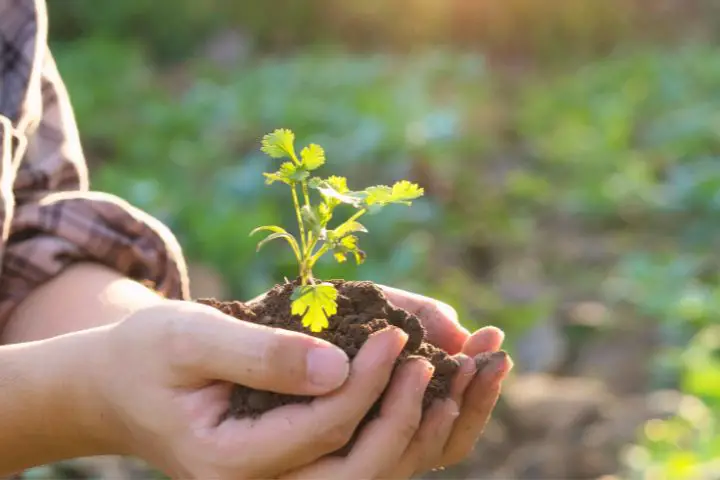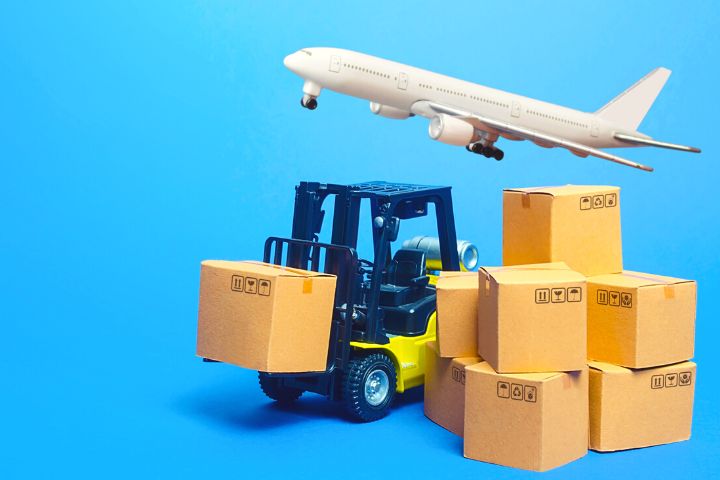Environmental Impact of Food Production | Where do emissions from food come from?
The explosion of globalisation has revolutionised many industries, none more so than the food industry. Going to grocery markets these days allows you to get the best produce from around the world. Oranges from Valencia (Spain), avocados from Mexico, coffee from Ethiopia and steaks from Japan. The benefits of globalisation have allowed for you to have the best of everything, delivered to your doorstep, but like with everything, it comes at a price.
With an astonishing global revenue of $8.66 trillion in 2022, and predicted annual growth of 6.7% over the next five years, the global food industry is getting bigger and bigger, but so is the carbon footprint. The food industry is not restricted by borders but all that transportation is greatly impacting the environment.
Related articles: Best Bokashi Bucket and Bokashi vs Compost
Land Clearing and Food Production
Land clearing, also known as deforestation, is the process of clearing an area of all its trees and wildlife to make space in order to then grow crops, raise cattle and cultivate the land for a specific purpose.
Food production is the biggest reason for land clearing.
To meet our global food demands, large sections, or in some cases entire rainforests are being cleared. Hundreds of thousands of trees are felled and entire ecosystems are destroyed to accommodate our preferred requirements. Land clearing is the primary driving force behind the extinction of wildlife species.
Soil Manipulation and Use of Fertilisers and Pesticides

Once the land is cleared the ground must be readied to grow food and this is a long and damaging process. First the ground must be overturned in an attempt to manipulate soil properties to create the best growing ground.
After the soil has been turned, the next step includes chemicals which can be harmful to the environment, yet are good for the growth of the crops. Herbicides are first sprayed in the soil to stop unwanted plants, such as weeds, from spurting out, as these will take the nutrients and water reserved for crops. Fertilisers are then applied to boost the nutrients in the soil in an attempt to maximise the quality of the crops. From when the crops are planted to when they are harvested, a variety of pesticides are also sprayed to aid in plant growth and keep away any harmful insects and unwanted plants.
This process is extremely detrimental as soil manipulation contributes greatly to soil erosion (more on that in just a little bit), and the chemicals applied are harmful not just to the habitat but also to the health of the people who consume the chemically grown and sprayed crops.
When chemicals are sprayed they are simultaneously discharged into the atmosphere and are damaging air pollutants. These chemicals are also susceptible to being washed away during heavy rainfalls. These invisible preservatives then find their way into a number of ecosystems such as water and soil, which are then consumed by a variety of animals and spread through the food chain.
Being part of the food chain, we also suffer from these misplaced chemicals as our bodies find it difficult to consume and digest these add ons. Our immune systems are able to handle small concentrations however the worry is, as the food industry continues to grow, this practice is becoming more and more commonplace, which will in turn become increasingly harmful to our health.

If we continue like this, the issue will soon become that unless you are growing your own food from start till finish, even if you buy and consume something considered to be healthy, such as fruits and vegetables, the chemicals they may be sprayed with could negate all the benefits.
Soil Erosion
Though soil manipulation could be considered important for crop cultivation, it is a big reason behind soil erosion, which reduces the quality and the quantity of the soil which are essential to ecosystems and wildlife.
When soil erosion occurs the topsoil is removed which is the most fertile layer of the soil. As soil quality directly impacts food, crops and foraging for wildlife, it is highly important to keep this top layer intact, which is exactly the opposite of what soil manipulation does. Those in the food or deforestation industry will have you believe that soil is a renewable source, though it’s very important to highlight that it takes 1000 years to generate just 3 centimetres of top soil!
Soil erosion prevention is highly important for a number of reasons which include;
- Soils are responsible for a number of key commodities such as fuel, fibre, ecosystem services, medicinal products etc.
- Strong and compact soil act as a sort of filtration system, stopping pollutants from reaching groundwater
- Soils are home to a quarter of biodiversity and play a crucial part in nature’s lifecycle
- Soils assist in fighting global warming and climate change as they collect and store carbon and reduce greenhouse gases and emissions in the atmosphere
Water

Water is the most underrated fundamental of the food industry. It’s used for cleaning, growing, washing, sanitising, brining, fluming and for sanitation and hygiene, amongst other things. Water is very often mismanaged because of how it’s taken for granted, and this is a mistake which could lead to irreparable damage in the near future.
Water has four major uses within the food production industry;
- Primary production – water used in agriculture for crop irrigation and for livestock farming, with water being as important for animals as for humans. Also used for hygiene and maintenance of equipment.
- Cleaning and sanitisation
- Processing operations
- Food ingredient
Water Diversion
Due to the continuously growing demand of international food, combined with food’s undeniable reliance on water, it’s no surprise large volumes of water are moved around for the sake of food production.
Unfortunately, water diversion causes a huge negative impact on the environment. As water is the nucleus for all wildlife, when water is moved on a large scale, it disrupts the natural habitat and ecosystems and majorly impacts fish and birds who use rivers and large bodies of water when migrating.
It is also responsible for habitat fragmentation, when sections of habitat are destroyed due to actions such as water diversion and land clearing, resulting in disconnected areas of habitat, as well as loss of biodiversity.
Food Transportation

You may only use the best ingredients to fuel your body, but that is coming at an increasing cost known as ‘food miles’. Similar to the air miles you use when you catch a flight, food miles calculate the carbon emission of the ingredients you picked up in the supermarket.
You must be aware that food flying in from overseas typically produces as much as 10 times more carbon emissions than food transported by road, and astonishingly 50 times more emissions than if the food is shipped in. So your health might be improving, however, the planet is suffering as a result.
These food miles are estimated to be responsible for 6% of the world’s greenhouse emissions! And that is a number experts are certain is growing year on year, as are our demands. What’s even more worrying is that when you combine food miles with the emissions and effects of land clearing, food production and the methane released by cattle, a whopping 30% of the world’s emissions are contributed to the food production industry.
An industry which is valued at over $100 billion annually is one which is both vital to our existence, yet is destroying it at the same time.
If you want to try and reduce your food miles start taking note of where your ingredients are coming from and calculate what mileage and how much emissions were produced, for it to get to you. Try buying your goods locally or at least from countries which are not too far from you when you can.
Food Waste

We all know that we shouldn’t waste food but sometimes we are just so careless. When we have overindulged, cannot eat further, yet still have food on our plates. Or even when we’ve been too busy and forgotten about what was in the fridge and when you finally come round to check it’s gone off and inedible.
These are very common mistakes, but in doing so you are contributing to more than 1.3 billion tons of food being wasted each year. A truly mind-blowing number, which equates to about $1 trillion dollars!
What makes matters worse is that 17% of all food produced and available actually goes directly to the bin! In developing countries, a significant amount of waste takes place during harvest period. Due to poor farming facilities and techniques as much as 40% of food waste losses occur during this time.
All of this food waste is damaging the environment. As a portion of food waste is left in landfill sites, the food rots and releases the dangerous greenhouse gas methane, and the rate we are going at now, 17 million tonnes of methane is being released into the atmosphere every year just by food waste alone! Unfortunately, food and agriculture only continue to consume approximately 25% of the world’s methane.
FAQ’s

How can I reduce my food waste?
- Buy more conservatively – we are often glutinous in our buying habits and end up wasting loads away. Be more aware and only buy what you feel you will realistically finish.
- Plan ahead! This can go a long way in helping you reduce your waste. Plan your meals for the week ahead so you know exactly what you need and always use your leftovers!
- Adjust the temperature of your fridge as if it’s too warm then fruit, vegetables and dairy will go off much quicker. It should be between 0 and 5 degrees.
- Don’t be afraid to freeze! If you’ve bought too much and won’t use it all in time just grab some freezer bags and use them in your own time!
- Compost, compost, compost! Some food waste will always exist – after all, we can’t eat things like banana peel! The next best thing we can do is to compost any food scraps and return it to where it came from – our soil!
How do I check my air miles?
There is no certain and simple formula which allows you to calculate your air miles though you can check online for air mile trackers which can help you.
The country of origin is the key indicator for how many miles the product has done, however, the method used to cultivate the produce is also taken into consideration.





